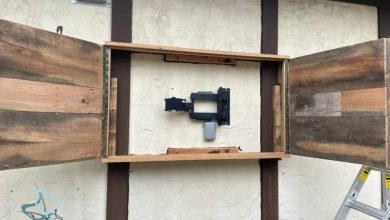What Is a Tenon
A tenon is a component of a mortise and tenon joint, which is a type of joint used to connect two pieces of wood at a 90-degree angle.
It consists of a peg (tenon) and a slot or hole (mortise).
The tenon is usually taller than it is wide for stability and has shoulders that rest flat against the mortise member when inserted.
The length of the tenon should be one-third of the thickness of the wood to prevent splitting or breaking.
Tenons can be made using hand saws, table saws, routers, or chisels.
Glue is typically applied to the joint during assembly to provide additional strength.
Mortises can be created using a drill, drill press, chisels, or a router.
Different shapes of pegs, such as square, rectangular, or round, can be used, and joints can be assembled at various angles.
Additional strength can be achieved by using a pin, nail, or screw.
Did You Know?
1. A tenon is a woodworking joint that has been used since ancient times. It involves inserting a projection or tongue (the tenon) from one piece of wood into a corresponding hole (the mortise) of another piece to create a strong connection.
2. The term “tenon” is derived from the Latin word “tenere,” meaning “to hold.” This highlights the primary function of a tenon joint, which is to secure and hold pieces of wood together in a reliable and durable manner.
3. Tenon joinery has been found in ancient Egyptian furniture dating back to 3100 BCE. This suggests that the technique has been refined and perfected over several millennia, serving as a testament to its effectiveness and longevity.
4. In Japanese woodworking traditions, a variant of the tenon joint known as “sashimono” is utilized. Sashimono involves intricate woodworking and often incorporates decorative elements, making it a combination of both functional and artistic craftsmanship.
5. In addition to wooden structures, tenon joints can also be found in other materials like stone and metal. They have been employed in ancient architectural wonders such as the temples of Angkor Wat in Cambodia and the ruins of Machu Picchu in Peru, demonstrating the versatility and adaptability of this jointing technique.
Overview Of The Mortise And Tenon Joint
In the realm of traditional woodworking techniques, the mortise and tenon joint stands as a tried and true method for connecting two pieces of wood at a perfect 90-degree angle. This classic joint relies on the combination of a mortise hole and a tenon tongue to create a strong and durable connection.
The mortise, which is a cavity or slot cut into one piece of wood, acts as the female component of the joint. The tenon, on the other hand, is a protrusion or peg that fits snugly into the mortise, thereby forming the male component of the joint. This design allows for the tenon to be inserted into the mortise, creating a solid and reliable connection.
Components Of A Mortise And Tenon Joint
To better understand the intricacies of the mortise and tenon joint, it is essential to explore its fundamental components.
The mortise, typically one third the thickness of the wood, ensures the tenon fits snugly without splitting or breaking. This careful balance allows for a secure fit while maintaining the structural integrity of the joint.
On the other hand, the tenon features shoulders that rest flat against the surface of the mortise member when inserted. These shoulders provide additional stability and prevent any unwanted movement or rotation within the joint. It is common for tenons to have a taller dimension than width, further enhancing their stability and structural integrity.
- The mortise is one third the thickness of the wood
- The tenon fits snugly without splitting or breaking
- The shoulders of the tenon provide additional stability
- Tenons often have a taller dimension than width
Guidelines For Proper Mortise Sizing
Achieving the ideal mortise size is crucial for a successful mortise and tenon joint. The mortise should ideally be one third the thickness of the wood, as mentioned previously. This proportion prevents the tenon from being too weak or too tight within the joint, striking the perfect balance between mobility and stability.
Creating a mortise can be achieved using various tools, including a drill, drill press, chisels, or a router. Each tool provides a different level of precision and efficiency, allowing craftsmen to choose the best option for their specific needs. The key is to ensure that the mortise is accurately sized and shaped to accommodate the tenon.
Understanding The Tenon’s Shoulders And Stability
The shoulders of a tenon are essential for providing stability to the mortise and tenon joint. They act as flat surfaces that rest against the mortise member, ensuring the joint’s strength and security. The shoulders play a crucial role in distributing the load evenly across the joint, thereby preventing weak points or stress concentration that could lead to failure.
To further enhance the stability of the tenon, its shape is typically taller than it is wide. This design choice increases its resistance to bending or twisting forces. Even under significant pressure or weight, the tenon remains stable and reliable, contributing to the overall strength of the joint.
- The shoulders of a tenon provide stability to the mortise and tenon joint.
- They distribute the load evenly across the joint, preventing weak points or stress concentration.
- The shape of the tenon, being taller than it is wide, enhances its stability.
- This design choice allows the tenon to resist bending or twisting forces effectively.
“The shoulders of a tenon play a vital role in providing stability to the mortise and tenon joint.”
Tools And Techniques For Creating Mortises And Tenons
Craftsmen have a range of tools and techniques at their disposal when it comes to creating mortises and tenons. For mortises, tools such as chisels, hand drills, drill presses, or routers can be used, each offering different levels of precision and efficiency. Likewise, for tenons, hand saws, table saws, routers, or chisels are commonly employed, with each tool catering to specific requirements.
It is worth noting that mortise and tenon joints can be assembled at various angles, depending on the project’s needs and aesthetic preferences. Additionally, for added strength and stability, pins, nails, or screws can be used to secure the joint further. These reinforcements act as an additional layer of support, ensuring the longevity and durability of the joint.
Check this out:
Frequently Asked Questions
What is the difference between a mortise and a tenon?
A mortise and a tenon are two integral parts of a traditional joint used in woodworking. The key difference lies in their shapes and functions within the joint. A mortise refers to the hole or slot that is created to receive the tenon. It is carefully chiseled or drilled into one piece of wood to accommodate the tenon. On the other hand, a tenon serves as a peg or projection on the other piece of wood that is inserted into the mortise. This peg-like structure ensures a strong connection when the two pieces are glued together during assembly. In summary, while a mortise is the receiving end of the joint, a tenon is the projecting part that fits into the mortise, ultimately creating a sturdy joint.
What is a tenon joint used for?
A tenon joint is commonly used in woodworking to securely join two pieces of wood at a 90-degree angle. Comprised of a mortise hole and a tenon tongue, this type of joint may appear straightforward, yet it is highly effective and has stood the test of time. Renowned for its remarkable strength and durability, it has been favored by craftsmen and artisans in the field for generations, including cabinetmakers and joiners.
What is another word for tenon?
Another word for tenon could be “jibe.” Jibe describes the action of two pieces fitting together or linking in a coordinated and seamless manner. It suggests that the elements coincide, conform, correspond, and harmonize perfectly, just like the interlocking parts of a tenon joint in woodworking.
Was Jesus a carpenter or a joiner?
Based on the scriptural accounts, it is believed that Jesus was indeed involved in the trade of carpentry. The book of Matthew suggests that Jesus was known as “the carpenter’s son,” indicating a connection to his father Joseph, who was a carpenter. This would suggest that Jesus likely gained skills and knowledge in the carpentry profession and may have practiced it himself. Therefore, it is reasonable to conclude that Jesus was both a carpenter and a joiner, specializing in woodworking and craftsmanship.


